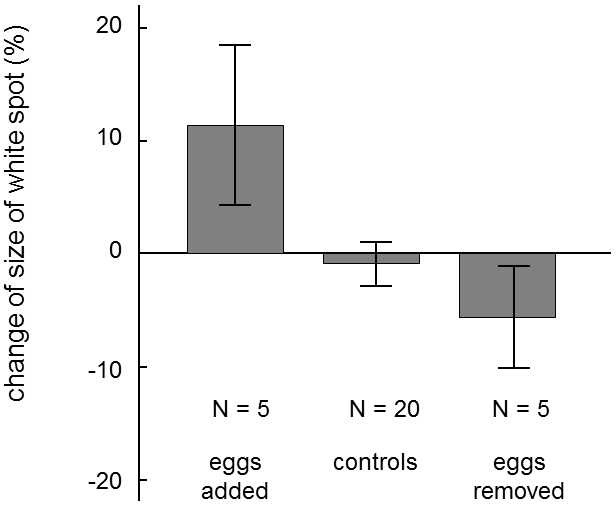XV.5.5.5 Secondary sexual traits can serve to indicate the momentary physiological condition and the degree of their expression in the individual can change
The degree of expression of secondary sexual traits can reflect the momentary physiological (health) condition of the individual. The degree of expression of secondary sexual traits can be temporarily or permanently reduced in individuals that are poorly fed or suffering from a disease. Consequently, a number of authors assume that secondary sexual traits enable females to determine whether their potential sexual partner is momentarily in good health or not. It is understandably more advantageous for the female to choose a male in good health because he will be able to invest more into care for the offspring.
Collared flycatcher (Ficedula albicollis) females prefer males with a large spot on their foreheads. It has been found that the size of the head spot in offspring and the size of the head spot in the subsequent nesting season in males are negatively correlated with the size of the batch of eggs (Fig. XV.9). If two eggs are added artificially to the nest, the offspring were less well fed on an average

Fig. XV.9 The effect of the physiological condition of a male on the degree of expression of a secondary sexual trait. The white spot on the head is an important secondary sexual trait in collared flycatchers (Ficedula albicollis). Females prefer males with a large spot. The size of the spot fluctuates during the season and between nesting seasons in dependence on the physiological condition of the individual and thus reflects both the genetic quality of the individual and the conditions to which it was exposed in the past. In the experiment, the batch of eggs was increased by two in five nests and reduced by two in five nests and the change in the head spot in the relevant males was monitored in the subsequent season. The average size of the egg batch in collared flycatchers is six eggs. The heights of the columns indicate the change in the width of the spot between the beginning of the experiment and the beginning of the subsequent nesting season. The results indicate that males that took care of a larger batch had reduced spot size in the subsequent season and, in contrast, males that took care of smaller batches had enlarged spots. According to Griffith and Sheldon (2001).
and the males had smaller head spots in maturity. A smaller spot was also formed on the males in the subsequent nesting season, probably as a consequence of overall exhaustion related to feeding the greater number of offspring (Gustafsson, Qvarnstrom, & Sheldon 1995). Similar results were obtained for great tits where the degree of expression of the secondary sexual trait, the area of the black band on the chest, was affected by the number of ectoparasites in the previous nesting season (Fig. XV.10). Once again, it is necessary to emphasize that this mechanism can function only when it is not worthwhile for the male to cheat, when the expression of large head spots is “cost-intensive”. For collared flycatchers, experimental data demonstrate that a white head spot increases light reflection and worsens the vision of the birds (Griffith & Sheldon 2001).s
